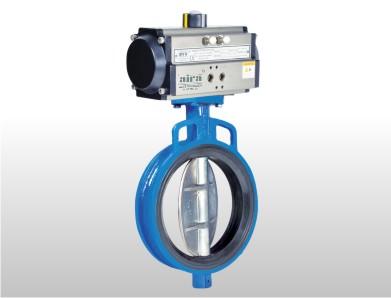How Does a Lug Type Butterfly Valve Work?

Lug type butterfly valves are a common type of valve used in many industries. But how do they work? In this blog post, we'll take a look at the lug type butterfly valve, and how it works, as well as the benefits of choosing this type of valve.
Introduction
A lug type butterfly valve is a quarter-turn rotational valve that is used to control the flow of fluids through a pipe. The valve gets its name from the lugs that are located on either side of the body, which are used to connect the valve to the line.
The lug type butterfly valve consists of a body, a disk, and a stem. The body is usually cast iron, ductile iron, or carbon steel. The disk is made from aluminum, brass, stainless steel, or plastic, and is attached to the stem. The stem is connected to the actuator, which is used to open and close the valve.
When the actuator is turned, the disk rotates within the body. When the disk is in the open position, fluid can flow through the valve. When the disk is in the closed position, fluid cannot flow through the valve.
What is a lug type butterfly valve?
A lug type butterfly valve is a quarter-turn valve that is used to control the flow of liquids and gasses. The valve consists of a disk that is connected to a stem, which is operated by a lever or handles. The disk is seated on a seat ring, with two lugs extending from the body of the valve. The lugs are used to connect the disk to the body of the valve.
The lug type butterfly valve is similar to a wafer type butterfly valve, but it has a different method of connection between the disk and the body of the valve. The main difference between the two types of valves is that the lug type butterfly valve has an increased pressure rating due to the increased surface area where the disk contacts the body of the valve.
The lug type butterfly valve is available in various materials, including metals, plastics, and composites. The most common material for the body of the valve is cast iron, but other materials such as stainless steel, aluminum, and bronze can also be used. The disk can be made from any number of materials, but it is most commonly made from ductile iron, stainless steel, or aluminum.
What are the benefits of a lug type butterfly valve?
Lug type butterfly valves offer a lot of benefits over other types of valves, including:
They are easy to install and maintain, due to their simple design.
They are capable of handling high pressures and temperatures.
They have a tight seal that prevents leakage.
They are available in a variety of materials to suit different applications.
How does a lug type butterfly valve work?
When a lug type butterfly valve is in the open position, the disk is rotated a quarter turn perpendicular to the flow of liquid or gas. This allows for an unobstructed flow through the valve. The lugs on the disk are used to connect the disk to the body of the valve, which prevents it from rotating more than a quarter turn. In the closed position, the disk is rotated so that it is parallel to the flow, which blocks the flow through the valve. The seal between the disk and seat ring prevents leakage.
Lug type butterfly valves are easy to operate and require little maintenance. They are available in a variety of materials to suit different applications.
Why choose a lug type butterfly valve?
Lug type butterfly valves offer a number of advantages over other types of valves, such as easy installation and maintenance, high pressure and temperature handling, and a tight seal that prevents leakage. They are also available in a variety of materials to suit different applications.
Lug type butterfly valves are easy to install because they do not require welding or threading. They can be installed quickly and easily with basic tools. Maintenance is also easy because the lugs allow the disk to be removed without having to disassemble the entire valve. Lug type butterfly valves can handle high pressures and temperatures, making them suitable for a variety of applications. The lug type butterfly valve's tight seal prevents leakage, which is often an issue with other types of valves.
There are many reasons to choose a lug type butterfly valve over other types of valves. Lug type butterfly valves are easy to install and maintain, handle high pressures and temperatures, and have a tight seal that prevents leakage.
Conclusion
Lug type butterfly valves offer many advantages over other types of valves, making them a popular choice for a variety of applications. Their easy installation and maintenance, high pressure and temperature handling, and tight seal make them an ideal choice for many industries. If you are looking for a reliable and efficient valve for your application, a lug-type butterfly valve may be a perfect choice.
Post Your Ad Here





Comments (2)
Shalini Mathur6
HR Manager
Thank you for providing this information. I am learning so much about Lug type butterfly valve now.
Abid Saiyad5
Abid Saiyad
Thank you for giving me this information.